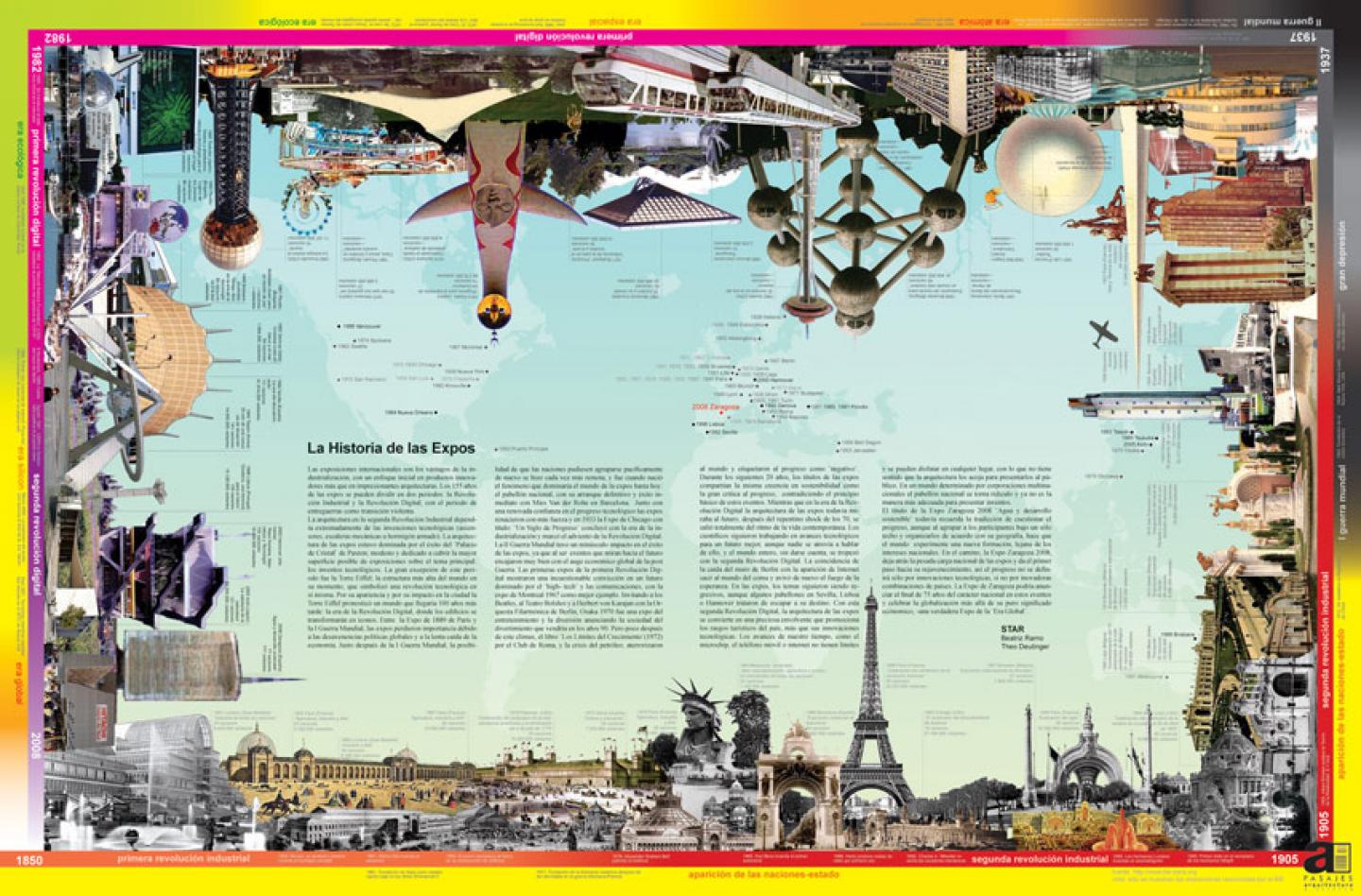World’s fairs are an offspring of the age of industrialization in Europe, with its initial focus rather on innovative products than on magnificent architecture of pavilions and convention halls. The155 years of World’s Fairs can be clearly divided in two periods, the Industrial Revolution and the Digital Revolution, with the time of the great wars as violent transition phase that cuts this 155 years in two perfect halves. As political principles, social life and technology changed radically during this time, as did architecture.
The structure and design of architecture in the 2nd Industrial Revolution was heavily depending on technical inventions, like elevators, escalators and reinforced concrete. The Expo-Architecture at this time was dominated by the of Paxton’s ‘Glass Palace’. Unpretentious and dedicated to cover as much exhibition area as possible, this early type of convention halls provided simply the stage for the main thing: technical inventions. The biggest exception of this period was the Eiffel-Tower, yet as world’s highest structure at its time, it symbolized a technical revolution on its own. In its appearance and its impact on the city the Eiffel-Tower gave a forecast on a world that would come 100 later, the time of the Digital Revolution, where buildings would turn into icons.
In the time between the1889 Expo in Paris and the First World War, Expos lost their importance due to global political frictions and the slow down of the economy; interesting enough it was also a period without big achievements in exhibition architecture. Right after the First World War the prospect that nations could get together peaceful was made all the remoter, yet out of this disbelieve a phenomenon appeared that would dominate the world Expos till today: the national pavilion.
The ultimate start-sign and immediate success of the architecture of national pavilions was the building of Mies van der Rohe in Barcelona. Together with a renewed believe in technological progress the world’s fair got blown in new life and the 1933 Expo in Chicago with its theme “A Century of Progress”, proved the rejuvenation of the idea of world’s fairs. At the same time it resumed the era of Industrialization and marked the advent of the Digital Revolution.
The Second World War had remarkably little impact on the success of World’s fairs. Since Expos are by their nature forward looking and progressive events, they fitted perfectly with the global economic upswing that set in after the war. The first fairs of the 1st Digital Revolution kept this promise high by showing an unquestionable believe in a future dominated by high-tech and communication. The Expos of Montreal 1967 and Osaka 1970 marked the top of this period with an enormous desire for showing intellectual and cultural awareness. Hosting the Beatles, The Bolshoi Theater and Herbert von Karajan with the Berlin Philharmonic Orchestra, Osaka 1970 was an Expo of games, entertainment and amusement, and extremely prospective by foreseeing the fun-society of the 1990´s.
Short after this climax at the Expo of Osaka, the release of the report “The Limits to Growth” (1972) by the Club of Rome followed by the oil-crisis, terrified the world and labeled ´progress´ swiftly as bad. In the following twenty-two years no World’s Fair of any broader meaning was held. All recognized World’s fairs in this period shared the same believe in sustainability as grand critique on progress, a condition that contradicts the basic idea of World’s Fairs. This depression is visible in the architecture of the Expos. While the buildings in the era of the first Digital Revolution were still forward-looking, after the sudden shock in the seventies, architectural expression in Expos came totally out of pace with contemporary live.
Scientists continued working on a better future through technological innovation, yet nobody dared to talk about it and the whole world slipped unnoticed into the 2nd Digital Revolution. The coinciding fall of the Berlin Wall with the emergence of the internet pulled the globe out of the coma and fueled the fire of hope again. In the Expos after, the themes remain regressive, yet some pavilions shown in Seville, Lisbon and Hanover try to escape their destiny but stay nothing more than good and sometimes hilarious architecture. Throughout the 2nd Digital Revolution Expo-Architecture turns more and more into a beautiful envelop that promotes a country’s touristic features rather than its technological inventions. Technological innovations of our time like the microchip, mobile phone and internet are borderless and can be enjoyed everywhere while architecture has no means to present it. In a world determinate by multinational corporations the architecture of the national pavilions seems ridiculous and for sure not the right medium for representing inventions. As in the very beginning of the World’s Fair, containers that show the upfront inventions gain extremely on importance.
The topic of the Expo Zaragoza 2008 “Water and Sustainable Development” remains in the tradition of questioning progress. However with its approach of collecting all participating nations under one common roof and organizing them according to their specific geographic features, the whole world experiences a new formation, far beyond national interests. In this way Expo Zaragoza 2008 leaves behind the heavy load of nationalism and makes a first step towards the rejuvenation of the World’s Expositions. Progress would not be solely defined by technological innovations but by daring and unprecedented combinations of countries. The Expo in Zaragoza could herald the end of a 75 year long nationalistic period and celebrate globalization beyond its pure economic meaning – a real Expo of the “Global Age”.
2007


